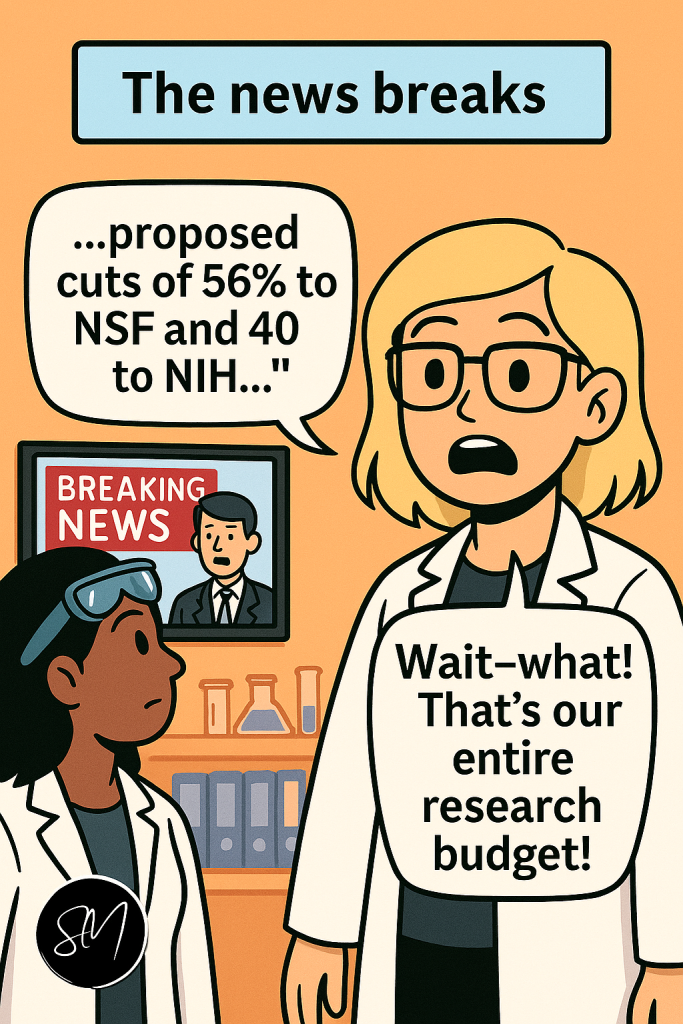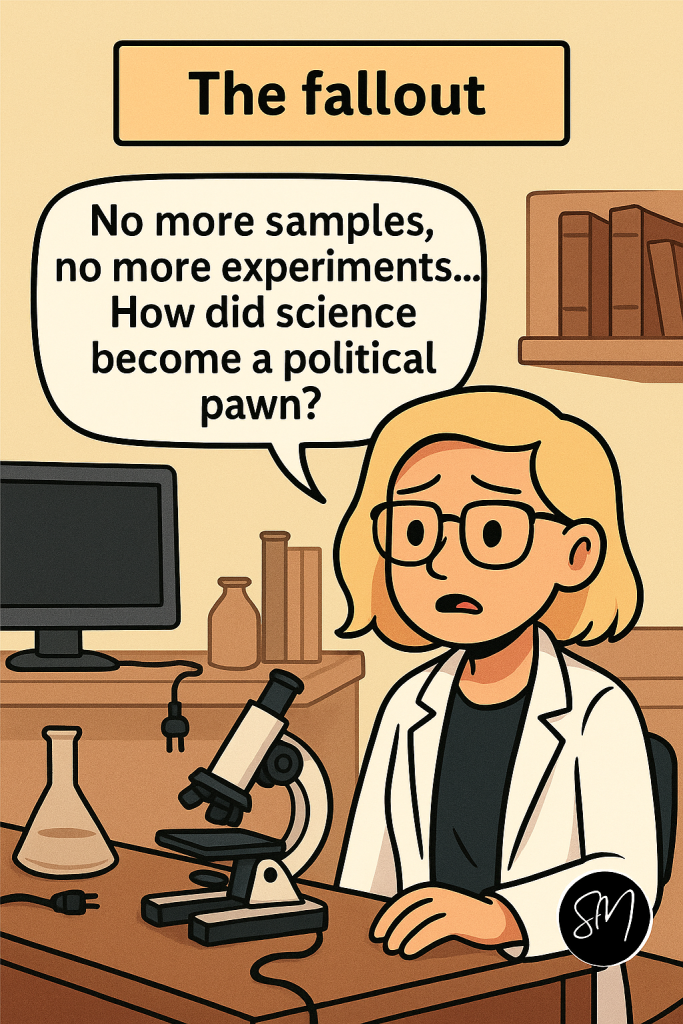Imagine you’re a young scientist in a US university lab, balancing test tubes and hope. Then one morning, your funding is slashed, your programme discontinued, and your research abandoned. That scenario may no longer be speculative. On 2 May 2025, the Trump administration proposed sweeping budget cuts to US science agencies for fiscal year 2026. If enacted, this could mark a historic shift in America’s science landscape—one where global leadership in innovation gives way to retreat.
The proposal is already causing deep anxiety across the research community. It calls for cuts so severe that prominent figures have warned of a collapse in the nation’s scientific pipeline. “If I were starting my career, I would be out of here in a heartbeat,” says Michael Lubell, physicist and policy expert at the City University of New York.
What’s being cut and why it matters
The White House proposal aims to reduce all non-defence spending by 23 percent. But science agencies face much deeper cuts. The National Science Foundation (NSF) would lose 56 percent of its budget, the National Institutes of Health (NIH) 40 percent, and the Environmental Protection Agency (EPA) 55 percent. NASA would see a 24 percent reduction, while the Centers for Disease Control and Prevention (CDC) faces a one-third budget cut.
These institutions are not merely bureaucratic entities. They fund cancer research, climate monitoring, pandemic response, space missions, and clean water projects. Slashing them risks devastating consequences for both scientific advancement and public wellbeing.
The administration argues that this is about eliminating waste and re-focusing investment. According to Victoria LaCivita, spokesperson for the White House Office of Science and Technology Policy, the goal is to end “woke science spending” and prioritise areas like artificial intelligence, quantum computing, and nuclear energy.
The assault on climate and social science
Some of the most targeted programmes relate to climate change, clean energy, environmental justice, and diversity in science. The NSF’s “broadening participation” programmes, which aim to attract under-represented groups into science, are set for an 80 percent cut.
Meanwhile, the EPA’s Office of Research and Development would be dismantled. Administrator Lee Zeldin announced that scientists will be reassigned to other offices, effectively gutting the agency’s internal research capability. One EPA scientist, speaking anonymously, warned that the move undermines essential work “required by statute and requested by states.”
This ideological framing—labeling environmental and diversity initiatives as radical or unnecessary—marks a stark departure from evidence-based policy. It paints science as a political battleground rather than a public good.
Biomedical research in peril
Perhaps most shocking is the proposed 40 percent cut to the NIH, the world’s largest biomedical research funder. The budget would shrink from 48 billion dollars to 27 billion. It also proposes collapsing the agency’s 27 specialised institutes into just five focus areas. Programmes focused on minority health and international research would be axed.
Carole LaBonne, a stem-cell biologist at Northwestern University, calls the plan “incredibly short-sighted.” Former NIH director Monica Bertagnolli denounced the administration’s justification—claims of “wasteful spending” and “risky research”—as “grossly inaccurate or false.”
Beyond the numbers, the message to the next generation of researchers is demoralising. The NIH supports thousands of labs across the country. A slash of this magnitude could delay drug development, stunt innovation, and drain talent from the field.
NASA and the end of Earth science?
NASA’s proposed budget would fall by nearly one-fourth, with its science division facing cuts of almost 50 percent. Among the casualties would be Earth science missions, climate-monitoring satellites, and the high-profile Mars sample-return programme.
Instead, the focus shifts to space exploration as a geopolitical tool. The budget allocates one billion dollars to unspecified Mars-focused missions and continues to prioritise Moon landings to beat China to the surface. However, the proposal also includes retiring the Space Launch System, a key component of US spaceflight infrastructure.
Critics warn this could usher in a “dark age” for NASA’s science efforts. While the allure of space conquest remains strong, the broader scientific mission is being sidelined.
From public health to quantum dreams
The CDC’s budget would drop from around nine billion dollars to six. Chronic disease prevention programmes would be discontinued. This comes despite Secretary of Health Robert F. Kennedy Jr’s stated support for such initiatives.
The Department of Energy (DoE) would see its science office budget cut by 13 percent, mainly affecting climate and clean-energy research. Meanwhile, high-performance computing and fusion energy remain supported, reflecting a strategic focus on future-ready technologies.
That dichotomy—cutting immediate public health and environmental protections while funding long-term tech dreams—raises critical questions about national priorities. Are we sacrificing today’s challenges for tomorrow’s prestige?
Scientific workforce on the line
The proposed cuts have implications beyond budgets. At the NSF, up to half of the agency’s workforce could be laid off. Kenneth Evans, a science-policy researcher at Rice University, questions whether the NSF could continue to function as Congress intended.
This isn’t just about staff. It’s about graduate students whose stipends disappear, postdocs whose positions are cancelled, and researchers who abandon projects midstream. Science isn’t a tap you can turn on and off. It relies on continuity, community, and long-term commitment.
A signal to the world
Internationally, the proposal sends a bleak message. The US has long been a global leader in science and innovation. These cuts risk undermining that status. They may encourage brain drain, where the best minds leave for countries with more supportive research ecosystems.
At a time when global challenges—climate change, pandemics, water scarcity—require unprecedented cooperation, isolationist policies are counterproductive. Science diplomacy matters, and so does consistent funding.


Not law yet—but still dangerous
It’s important to note that this proposal is not final. The US Congress holds the purse strings. However, several Republican leaders have expressed support. Tom Cole, chair of the House Appropriations Committee, praised the budget for trying to “restore a government that serves the people—not itself.”
Jennifer Zeitzer, of the Federation of American Societies for Experimental Biology, believes Congress will not approve cuts of this magnitude. Yet the fact that such a budget was proposed—and may gain traction—sends shockwaves through the scientific community.
The timing matters, too. Many grants are planned years in advance. Even the suggestion of instability can disrupt planning, hiring, and international collaborations.
What happens if the cuts go through?
The long-term effects could be catastrophic. Fewer discoveries. Slower medical breakthroughs. Weakening of evidence-based policymaking. Damage to America’s competitiveness in technology and innovation. Increased vulnerability to health and climate crises.
And a generation of young scientists may decide to abandon their careers before they begin.
Sudip Parikh, CEO of the American Association for the Advancement of Science, called the potential consequences “catastrophic.” This isn’t hyperbole. It’s a plausible future.
A battle for the soul of science
At its core, this debate is about the value of science in society. Is it a partisan luxury? Or is it the foundation of progress, health, security, and global cooperation?
The 2026 budget proposal doesn’t just aim to cut numbers. It seeks to reshape the role of science in American life. Whether that vision becomes reality depends on the choices of lawmakers—and the voices of voters.
Science is not infallible, but it is indispensable. It thrives on scrutiny, peer review, and persistence. When we defund it, we don’t just save money—we risk erasing knowledge, silencing discovery, and surrendering leadership.
Reference
Tollefson, J., Garisto, D., Kozlov, M., & Witze, A. (2025). Trump proposes unprecedented budget cuts to US science. Nature, 641(8063), 565-566. https://doi.org/10.1038/d41586-025-01397-1







